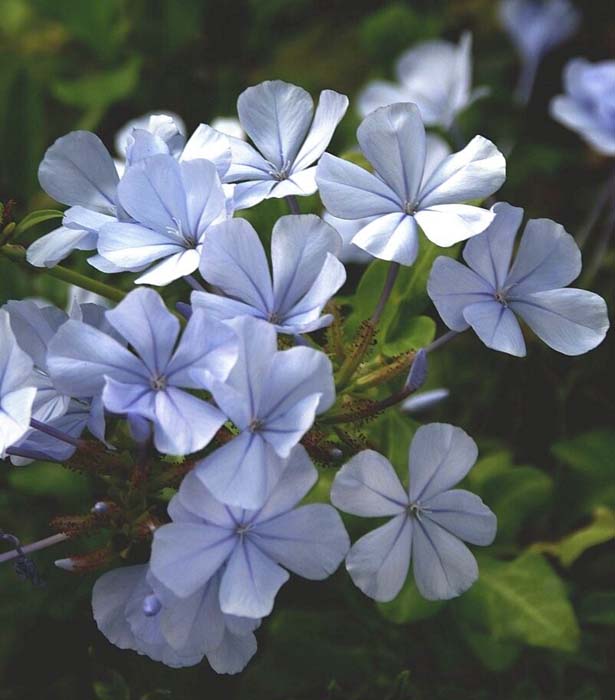Yarden July 2023
Published 1:18 pm Tuesday, July 4, 2023

- FEELING BLUE: The Blue Plumbago will also add to any Independence Day arrangement or back-yard garden.
JULY WEATHER
In early July, the Earth is farthest away from the sun. This probably does not compute in most people’s minds because it is summer here in the Northern Hemisphere. However, remember that it is not our distance from the sun that determines our seasons; it is the tilt of the Earth’s axis that creates our seasons. In summer, our part of the Earth is tilted toward the sun. As a result, July is the hottest month of the year, with an average high of 91⁰ and an average low of 72⁰.
Trending
Although July has 14 hours of daylight, it is the cloudiest month, during which the sky is overcast or mostly cloudy 56% of the time, on average. July typically has the most “wet days,” with almost 18 days having at least 0.04 inches of precipitation. According to Weatherspark.com, on any given day in July, the chance of rain is 60%, with July 31 having the greatest chance of all. With all this data, it is easy to understand that July has the most muggy days; about 30 days are characterized by Weatherspark.com as “muggy or worse!”
I looked at the forecasts for violent weather this summer. July is the peak month for such weather, during which more than 500 events were reported over the past 40 years. However, I am sure you are aware that high, record-breaking temperatures occurred last month, (June) in Texas and the American Southwest and northern Mexico. A “monster” thunderstorm in northern Texas created a tornado on June 22. The first tropical storms, named Bret and Cindy, have already formed in the Atlantic Ocean, nearly 2 months earlier than normal. Although these storms were not expected to be major threats to land, they might be an early indication that we are in for an active hurricane season. Sea surface temperatures are higher than normal now, too, and scientists know that this is an indication that land-falling storms are more likely to develop. Keep a look-out on the weather this month; as David Marshall says, “July weather can be fickle.”
SIGNIFICANT JULY “YARDEN” DATES
Monday, July 3 – Tuesday, August 11 – Dog Days of Summer. These days have nothing to do with dogs panting in the sweltering heat of summer. Instead, they were named by the ancient Greeks and Romans because of the “dog star,” Sirius, which is the brightest star in the sky besides the sun. Sirius appeared to rise just before the sun at this time of year. Sirius has predicted the time of extreme heat since ancient times.
Tuesday, July 4 – Independence Day. Happy Birthday, United States of America! “Bold stripes, bright stars, brave hearts.” Let freedom ring long, loud, ceaselessly and clear! Celebrate this important day with a few festive pots plants with red, white and blue blossoms. I know that blue flowers are sometimes hard to find but here are a few: blue lobelia, delphinium, morning glory, petunia, plumbago, salvia, scaevola and veronica.
Thursday, July 6 – Earth at Aphelion. This is the date on which the Earth is farthest from the sun. At 4:06 pm, local time, Earth will be 94,506,364 miles away from the sun. We are farther away from the sun in the summer, not the winter, in our hemisphere.
Trending
Thursday, July 20 – Man on the Moon. This date commemorates the day man first walked on the moon. On July 20, 1969, Apollo 11 Commander Neil Armstrong stepped off the Lunar Module, Eagle, and walked upon the surface of the moon. Buzz Aldrin soon joined Armstrong and they left a plaque saying, “Here men from the planet Earth first set foot upon the moon. July 1969 A.D. We came in peace for all mankind.” Do you remember that day? I’ll never forget it!
Saturday, July 29 – National Rain Day. Throughout history, people have recognized the importance of rain and celebrated this life-giving force. I like this story, which I learned decades ago when we lived about 28 miles from Waynesburg, Pennsylvania. In the 1800s, a Waynesburg, pharmacist noticed that it always seemed to rain on July 29th. As a result, he began keeping a record of the instances of rainfall on that date. After the 1920s, his brother continued to keep the record, and sure enough, it continued to rain pretty consistently on that date. What had begun as a local event spread when a newspaperman started reporting stories about it. Now, Waynesburg, Pa., receives calls from around the world to learn if it is raining on July 29! Not only that, others have adopted Rain Day. This has become a great way to encourage awareness of the importance of rain and the understanding that rain is not universally plentiful.
Weatherspark.com predicts that our rainiest day of the year is July 31, with a 66% chance of precipitation. Join me in remembering to see if we receive rain on Saturday, July 29.
IN THE NEWS
1) THE IVORY-BILLED WOODPECKER
Since the middle of the 20th Century, the ivory-billed woodpecker has been considered by many experts to be extinct. But recently, evidence has been building that the bird still exists in Louisiana and possibly other locations, as well, and should be removed from the list of endangered species. A major problem, however, is that is no clearly identifiable photographic proof. Ornithologists are keeping a close watch on the situation.
2) EARTH’S SPIN HAS CHANGED!
On June 15, 2023, the American Geophysical Union (AGU) made an astonishing announcement: the pumping of groundwater by humans (for agriculture, mining, and many other uses) and adding it to the surface has shifted Earth’s mass enough to slightly change Earth’s spin and to cause Earth’s rotational axis to increase its rate of wandering by about one yard over the past 2 decades.
The redistribution of the groundwater in the “midlatitudes,” (that is, most of North America, Europe and much of Asia) has had the most impact on the Earth’s spin. Relocating groundwater has also contributed to sea-level rise.
Scientists say this change in Earth’s rotational pole will not affect our seasons but on a larger time scale, this drift could impact climate.
TO DO
There is still time to plant some heat- loving veggies. Plant the following no later than July 20 to allow time to mature before frost: corn, cucumbers, lima beans, okra, pole beans, tomatoes, snap beans and squash.
Plant that big pumpkin for Halloween!
Harvest vegetables regularly to prolong production and to enjoy peak freshness.
UGA Extension Office suggests that we “eat ‘high on the hog’ on our garden’s produce in June and July but preserve enough to last during the winter months ahead.
A garden needs one inch of rain or water each week. Water deeply and less often. Early morning is the best time to water. Evening watering is less desirable because plant leaves that remain wet through the night are more susceptible to fungus diseases.
Mulch plants to reduce water loss; it also helps prevent weeds.
Check the soil moisture of container grown vegetables and flowers daily. As the temperature rises, some plants may need water twice a day.
Watch the leaves of your tomato plants for signs of leaf spot diseases.
Keep deadheading flowers to prolong bloom-time. Pinching back herbs like basil, mint, oregano, and savory to promote bushy growth.
Raise the blades on your mower, Mow cool season grasses at 3 or 3.5 inches from the ground; up to 4 inches from the ground for tall fescue and perennial ryegrass; and 2 to 2.5 inches from the ground for warm season grasses.
JULY QUOTE
We come from the earth. We return to the earth. And in between we garden. ~ Anonymous, from garden.org calendar, July 2022
Pat Pankey writes this column for Thomasville Garden Club, Inc. as a service to the community. Thomasville Garden Club, Inc. welcomes new members. If you are interested, please contact Membership Chair Vicky Johnson at 224-0590 or any current member.





